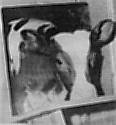FEW PEOPLE realize that cows have to be subjected to pregnancy every year so that milk, cheese, butter, and cream may be produced. Many imagine that the cow is relieved of her surplus milk after her calf has been satisfied; but in fact hardly any cows in the dairy herds are permitted to suckle their calves for more than a few days, if at all."Dairy cows are now nearly always reared by hand (that is, separated from the mother cow) so that the milk which the cow provides can be sold."(1) "Separating the calf from the mother shortly after birth undoubtedly inflicts anguish on both. Cattle are highly intelligent, and attachment between the calf and the mother is particularly strong."(2)
The calves have four possible fates:
1. They may go to the slaughter almost immediately-probably to provide veal for veal and ham pies. Rennet, used to make most commercial cheeses, has to be taken from the stomach of a newly born calf.
2. They may be much more unfortunate, going to a white-veal unit to spend the whole of their lives shut up in narrow wooden crates. After the first few weeks they have no room even to turn around. They may be fed on a special liquid diet designed to promote maximum growth in the minimum time, and to kepp their flesh "fashionably white." They are denied the roughage that their special digestive system requires, so they are often reduced to eating their own hair or nibbling at their crates.
They are given no bedding because their craving for solid food would make them eat it. Iron intake is kept to the minimum necessary for survival lest the meat be tinged with red.Many emerge from their crates at the end of their 14 weeks of existence suffering from stomach ulcers and abscesses, and with legs too shaky to support them as they are driven into the slaughterhouse truck. Calves at large are normally active and playful animals.(3)3. It is claimed that "80% of the beef produced is a by-product of the dairy industry."(4) Surplus calves from the dairy herds are often sent to market when a week old (or less) and bought for rearing in intensive beef units. Fed for 12 weeks on a largely cereal diet, they are encouraged to overeat and are kept closely confined so that the minimum proportion of the food is used up for their bodily functions. "There is danger of poisoning due to overeating."(5)
4. If female, the calves may be deemed suitable to raise as dairy cows. Dairy cows are removed as soon after birth as possible so that "the cow may settle down again in the herd," meaning she is granted a minimum time to get over the strain of her frustrated pregnancy so that her milk can go to produce the all-important profit.
Fed on milk substitutes, the calves' development is encouraged so that at 18 to 24 months they can begin the cycle of continuous pregnancies. Each year she hopefully produces a calf which means that for 9 months of the year she is pregnant. And for 9 months of the year she is milked twice a day. For 6 months she is both pregnant and lactating.Giving birth is often a prolonged and painful business for the cow, to be rewarded only by separation from her baby. Cows often cry out and search for their calves for days after they are taken away. When after years of exploitation their milk yield drops, they are promptly sent to the slaughter, often to become hamburger or pet food.For most cattle there are long wearisome journeys, rough handling and standing in market places, before being taken to other farms or to the slaughterhouse. The "humane" killing metods lessen the pain of the death blows but not the terror of waiting and the violence of the handling that must precede their use. The dairy industry is inseparable from the cruel exploitation and degradation of helpless, highly intelligent animals.And all this to produce food that is not necessary, and indeed is becoming incresingly seen as potentially hazardous to humans at any age. Calves need cow milk; human babies should have their own mothers' milk, and children and adults the solid foods appropriate to their dentition and digestive systems. These can easily be selected from richly varied plant sources.Where necessary or desired, for babies and children, invalids, and those who still like to take milk, delicious non-animal milks are available. There is also a good variety of vegan cook-books featuring a full spectrum of delightful and nourishing completely animal-free recipies.
